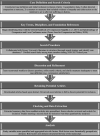Epidemiology of compassion: A literature review
- PMID: 36467146
- PMCID: PMC9714454
- DOI: 10.3389/fpsyg.2022.992705
Epidemiology of compassion: A literature review
Abstract
Psychology and neuroscience have contributed significantly to advances in understanding compassion. In contrast, little attention has been given to the epidemiology of compassion. The human experience of compassion is heterogeneous with respect to time, place, and person. Therefore, compassion has an epidemiology, although little is known about the factors that account for spatial or temporal clustering of compassion or how these factors might be harnessed to promote and realize a more compassionate world. We reviewed the scientific literature to describe what is known about "risk factors" for compassion towards others. Studies were included if they used quantitative methods, treated compassion as an outcome, and used measures of compassion that included elements of empathy and action to alleviate suffering. Eighty-two studies met the inclusion criteria; 89 potential risk factors were tested 418 times for association with compassion. Significant associations with compassion were found for individual demographic factors (e.g., gender, religious faith); personal characteristics (e.g., emotional intelligence, perspective-taking, secure attachment); personal experience (e.g., previous adversity); behaviors (e.g., church attendance); circumstantial factors during the compassion encounter (e.g., perceptions of suffering severity, relational proximity of the compassion-giver and -receiver, emotional state of the compassion-giver); and organizational features. Few studies explored the capacity to receive, rather than give, compassion. Definitions and measures of compassion varied widely across disciplines; 87% of studies used self-report measures and 39% used a cross-sectional design. Ten randomized clinical trials documented the effectiveness of compassion training. From an epidemiologic perspective, most studies treated compassion as an individual host factor rather than as transmissible or influenced by time or the environment. The causal pathways leading from suffering to a compassionate response appear to be non-linear and complex. A variety of factors (acting as effect modifiers) appear to be permissive of-or essential for-the arising of compassion in certain settings or specific populations. Future epidemiologic research on compassion should take into account contextual and environmental factors and should elucidate compassion-related dynamics within organizations and human systems. Such research should be informed by a range of epidemiologic tools and methods, as well as insights from other scientific disciplines and spiritual and religious traditions.
Keywords: compassion; empathy; epidemiology; psychology; public health; risk factor; sociology; training.
Copyright © 2022 Addiss, Richards, Adiabu, Horwath, Leruth, Graham and Buesseler.
Conflict of interest statement
The authors declare that the research was conducted in the absence of any commercial or financial relationships that could be construed as a potential conflict of interest.
Figures


References
-
- Armstrong K. (2009). The case for god. New York: Alfred A. Knopf.
Publication types
LinkOut - more resources
Full Text Sources
Miscellaneous

